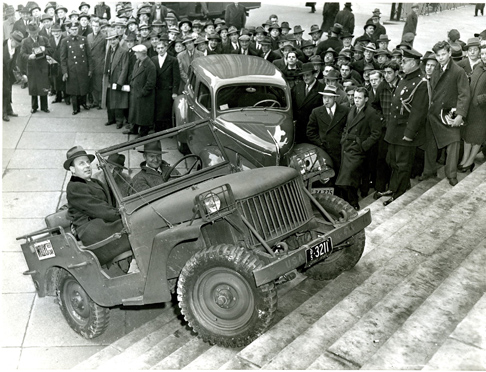The city of Toledo was built by glass. And auto parts, Jeeps, scales and more.

This gold Toledo Scale from around 1929 is seen in Georges LaChance’s painting titled “O.N. Teall — Final Inspection.” Both are part of the “Wholly Toledo” exhibit; the painting belongs to the Canaday Center, and the scale is on loan from the Maumee Valley Historical Society.
“We have been collecting records of Toledo businesses for many years,” said Barbara Floyd, director of the Canaday Center and university archivist. “We preserve the historical records of the three largest glass companies: Libbey-Owens-Ford, Owens-Illinois and Owens Corning. We have the records of Toledo Scale and The Andersons, too, among many others, so it seemed like we should do an exhibit that looks at the economic history of the city overall, showcasing some of the companies that had a huge impact on the city.”

This 1940 photo in the exhibit shows the Willys-Overland Jeep test vehicle being driven up the steps of a building in Washington, D.C., to show off its versatility. The company produced 1,500 models for the government in 75 days to help the war effort.
• “Future Great City of the World,” a pamphlet from 1868 by Jesup W. Scott, Toledo real estate developer and newspaper editor, who founded the Toledo University of Arts and Trades, which later became The University of Toledo;
• Libbey Glass Co.’s doll and men’s ties made from spun glass, the precursor to fiberglass, that were displayed at the 1892 World’s Columbian Exposition;
• A signed copy of a book on die-casting written by Herman Doehler, who invented the die-casting process and in 1907 started Doehler Die-Casting (later Doehler-Jarvis), which was the first major manufacturer of vehicle hood ornaments, several of which are display;
• A catalog from the 1912 inaugural exhibit at the Toledo Museum of Art, which is still free today thanks to glass pioneer and founder Edward Drummond Libbey;
• Two watercolor paintings by James M. Sessions for the “Jeep at War” advertising series, which promoted the vehicle’s versatility;
• A scale weighing more than 200 pounds from Toledo Scale and a series of paintings by Georges LaChance from 1928 to 1930 that pay tribute to the company’s workers; and
• “M*A*S*H” scripts from Toledo native Jamie Farr, whose character Maxwell Klinger mentioned Tony Packo’s during several episodes and helped the local restaurant become a national brand.
The exhibit also features a case dedicated to alternative energy.
“We actually discovered Libbey-Owens-Ford was one of the first companies to really tout solar energy, especially in housing. They developed the Thermopane window that turned windows from sources of heat loss into sources of energy,” Floyd said. “Owens-Illinois also did some development of solar collector tubes.”
UT’s world-renowned research in photovoltaics and thin-film solar panels also is noted.
“While alternative energy is a bright spot for the city in the 21st century, since the late 19th century, Toledo has gone from a manufacturing economy to a service economy, from a period of growth to one of steady decline, from large to somewhat smaller, from union to non-union, from local ownership of its major businesses to outside investor control,” Floyd said. “But if we look at our city today, we see important marks left by the great industrial and commercial leaders that continue to make for a good quality of life in spite of these trends.”Some of those marks will be discussed by Dr. Stuart W. Leslie, professor of the history of science and technology at Johns Hopkins University, at the exhibit opening. His talk is titled “Heart of Glass: The Architectural Legacy of Toledo’s Signature Industry.”
“The talk looks at five buildings that have defined the Toledo skyline — the Libbey-Owens-Ford Building, Fiberglas Tower, Owens-Illinois’ One Seagate Center, the Owens Corning world headquarters and the Toledo Museum of Art’s Glass Pavilion,” he said. “These buildings said, in steel, glass and fiberglass, this is who we are; this is what we do; this is how we do it. They are a revealing corporate and civic memoir of Toledo.”
The exhibit will be introduced by a short documentary, “Wholly Toledo,” which was created by Ashley Bouknight, a recent University of South Carolina graduate, who interned at the Canaday Center over the summer.
“I think there’s something to be learned on how we move into the future by knowing where we came from the past. For example, I think you can see the connections between the glass industry and the solar industry,” Floyd said. “A lot of young people today probably don’t realize how many industries were in Toledo and how important the city was to the country. This is an opportunity to remind everyone.”
“Wholly Toledo: The Business and Industry That Shaped the City” will be on display in the Canaday Center through Friday, Aug. 12. Viewing hours are Monday through Friday from 8:30 a.m. to 5 p.m.
The program is made possible in part through the support of the Ohio Humanities Council, a state affiliate of the National Endowment for the Humanities.
For more information on the free, public exhibition, call 419.530.4480.